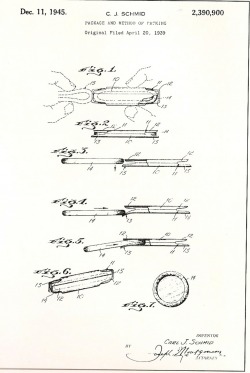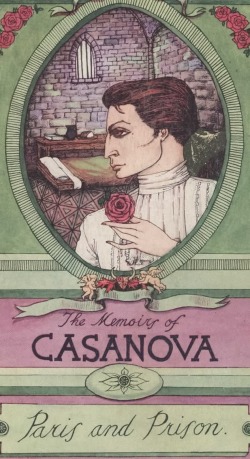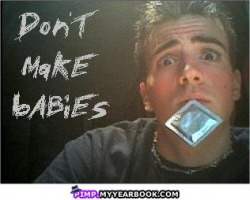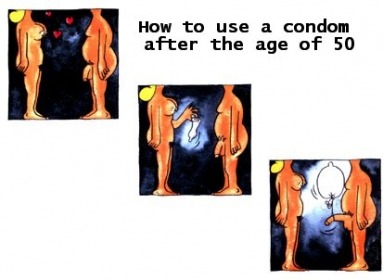Condoms and politics in India

Candidate Anand Prakash Sharma chose the logo to spread awareness about HIV and Aids.
According to the country's electoral laws, any candidate can opt for symbols which have not been given to other political parties or politicians, however, the Election Commission has advised Mr Sharma not to use a condom as his logo. He planned to take legal action if the commission refused to allow him to use his chosen symbol.
What neither the politician nor the commission may have realized is that the humble condom has been part and parcel of politics...at least making fun of them...for years, as with this "joke," which began to make the rounds in the 1970s under American president Jimmy Carter.
Funny C ads (?)
Advice for sweaty sex in the summer
- - -
Get ready to play outside with this inspiring bedside read. The title pretty much says it all -- 101 Places to Have Sex Before You Die (Simon & Schuster, $15.50). The journal-style book offers handy hints for escaping the sexual everyday, so if you're looking to get action outside of the bedroom, this will get you started.
- - -
Who knew skinny dipping could get even sexier? Get wet this summer with the completely waterproof lubricant, Pink Silicone. It's pool, lake and shower friendly. Find it at the shop for $20 or visit: comeasyouare.com
With a big name like X2, the latest condom from LifeStyles has a lot to live up to. Not just your plain old run-of-the-mill rubber, the X2 packs an extra pleasure punch with the help of a gel lubricant containing stimulating menthol and the natural amino acid L-Arginine on the inside and outside of the condom.
Added bonus: A sweaty, between-the-sheets workout sure beats going to the gym on hot summer nights.
India's homophobic history

From the The Globe and Mail (Canada), June 19, 2009
India's gay community fights for 'dignity';
The cop strode up to Rajiv M., gave him a shove and demanded to look in his backpack. Rajiv handed it over and the cop pulled out a condom, and asked why Rajiv had it. "I said it was for sex," Rajiv recalls, a bold if obvious answer that he knew was going to irritate the cop. But he wasn't feeling deferential.
The police officer demanded Rajiv's money, and his cellphone. "I said, 'Why should I give it to you?' "
The cop grew more menacing: Next he demanded oral sex. Rajiv refused that, too, so the cop hauled the slight 21-year-old to a nearby police station and began the motions of charging him with the crime of homosexuality. When eventually he realized that Rajiv's dad was also a police officer, he let the young man go.
This nasty little piece of attempted extortion took place not in a gay bar, not in an alleyway late at night, but in the middle of a hot spring afternoon in Delhi last year, when Rajiv was standing at a crowded bus stop. "It's India," Rajiv said with a shrug full of bravado. "So he could do something like this in the open."
Rajiv, tousle-haired and deliberately camp, told this story a few weeks ago at a Delhi drop-in centre for gay and transgendered men, where he goes a couple times a week. Everyone had a similar story, except most had gorier endings. All the men had been harassed and detained by police who demanded money and, with no trace of irony, also often wanted sex, with the threat of charging and exposing the victim as a homosexual.
The police invoke Section 377 of the Indian Penal Code, the law that criminalizes "carnal intercourse against the order of nature," including homosexual acts between consenting adults, with a possible sentence of life imprisonment. The law is almost never used for actual prosecutions: Men would have to be caught fully engaged in a sex act to hold up a case. No one has been convicted under 377 in 20 years. But few police officers are interested in actually enforcing the law. They prefer it as a blackmail tool.
Now, however, a fledgling gay community is waiting on tenterhooks for a verdict from the Delhi High Court, expected soon, on a public-interest litigation aimed at decriminalizing same-sex activity - and ending a plague of state-sanctioned homophobia that has led to rape, extortion, suicide and the spread of HIV-AIDS.
If they win - if the law is struck down, and many legal experts believe it will be - it will be a big shift in a still deeply conservative culture. There will be huge ramifications for India - where the courts seem to be out ahead of most of the population - and for the rest of South Asia and the developing world, where only a handful of countries have legally enshrined gay rights.
"Although the jails are not full of people arrested by 377, to say it doesn't have a violent effect in the community is totally false," said Gautam Bhan, a gay activist in Delhi and co-editor of the anthology Because I Have A Voice: Queer Politics in India.
Gay people are afraid to disclose their sexuality to their doctors, the human-rights commission won't touch issues such as men who lose their jobs, AIDS organizations have been raided for abetting obscenity because they give out condoms to gay men, he said.
"For us as activists, our hands are constantly tied. So to argue that just because this law does not appear in court records and people are not charged is irrelevant ... the law is alive and well in the lives of gay people in India."
The case to change the law was filed by the Naz Foundation, one of India's leading AIDS organizations. Naz was founded by Anjali Gopalan, a journalist and social worker who worked in New York in the 1980s, and lost gay friends at the height of the American HIV epidemic. When she came home to India in the early 1990s, she looked for similar initiatives, where she could volunteer as she had in New York, but there was nothing. There was no discussion of HIV, even though the virus was already circulating widely in communities of truck drivers, sex workers and injecting drug users. And there were no data on the number of gay men and incidence of HIV, although the experience of countries such as South Africa showed clearly that communities of gay men were affected early and hard in the developing world, too.
So in 1994, Ms. Gopalan started by persuading a couple of men she knew to show her the cruising zones of Delhi. At first, she was met with hostility: "The older queens in the park were saying, 'She's just come from America and she doesn't want you to have sex with us.' And I was saying, 'Have sex with anything that moves, but use a condom.' "
Soon she persuaded a doctor friend to come with her, and he began treating sexually transmitted infections and giving HIV tests behind the bushes. She noticed one big difference from New York: "Here all the gay men I was dealing with were married."
Married to women. So sacred is marriage in Indian society that many men who were attracted to men found it far easier in terms of family and social pressure, and often, more acceptable on their own terms, to marry a woman, and produce a couple of obligatory children, but satisfy sexual desires with long-term lovers or men they met in parks.
It soon became clear to Ms. Gopalan that if many of these men were testing HIV-positive, a lot of their oblivious wives would, too - if they had any idea or access to testing. Which they didn't. "And I got really mad that women had to go through that."
By the late 1990s, Naz had grown into a small charity that offered a hospice for the dying, a drop-in clinic and counselling services.
But there was a problem: The organization's outreach workers kept getting arrested while giving out condoms or sharing information on HIV with men cruising in parks or public toilets. The police charged them with obscenity and abetting an illegal act. They were rarely prosecuted, but their would-be clients were frightened off.
Meanwhile, counsellors on the phone lines were consoling despairing, often suicidal gay men and women who were being forced into marriages or shunned by their families. "We do lots of work with young gay people, telling them it's natural and it's not wrong, and in the end, they say, 'If it's so normal and natural, why is there this law?' " Ms. Gopalan said. "Or we work with their families, and in the end, they say, 'Okay, I can accept it for my son, but if it's so normal why is there this law?' "
Ms. Gopalan, as practical as she is fierce, decided it was ridiculous that the country's anti-HIV efforts were being hamstrung by a 150-year-old British law. So she enlisted some human-rights lawyers, and they went to court.
Naz was the initial plaintiff, but as the case dragged on, it emboldened the gay and lesbian community, and a new coalition of gay groups and human-rights organizations, called Voices Against 377, joined the AIDS organization in the case. That group filed a second petition, specifically asking that the law be changed on the basis of the equal rights of gay, lesbian and transgendered citizens. "It was very important to us politically that we expand the ambit of the case to talk about rights," said Mr. Bhan, who is part of the group.
The government countered that homosexuality is inherently "against Indian culture" and that the majority of Indians opposed legalization.
"Unnatural carnal intercourse is abhorrent to civilized society - even if consent is given, that is immaterial," said Solicitor-General P.P. Malhotra. "Our moral values require one man and one woman, his wife ... law is what society feels to be immoral."
He also argued that legalizing homosexuality would lead to more gay sex and so more transmission of HIV and that the law was necessary to protect men from AIDS.
Mr. Bhan and his compatriots countered that, in fact, homosexual love has a history in India going back to ancient times, citing epic poems and loving couples chiselled into temple sculptures. They also ran a huge open letter in daily newspapers, enlisting prominent personalities to support decriminalization, pillars of society including retired army generals, a former UN under-secretary-general, Nobel Prize winning economist Amartya Sen and even some veterans of the freedom struggle against Britain. "We sensed the change of mood, especially among the young. We wanted to say, 'You can't just easily say people won't accept it.' It's not true any more," Mr. Bhan said.
It complicates the legal battle that the law currently covers all "unnatural sexual acts," and is the only legislation pertaining to child sexual abuse, so the gay groups cannot ask that it be repealed all together.
In the course of the trial, the pro-decriminalization forces received backing from an unexpected quarter, the government's own Health Minister, Anbumani Ramadoss. Dr. Ramadoss said legalization would encourage gay men to access HIV-prevention services and stop impeding health workers and social workers who tried to assist them. But he also provided gentle chiding to his fellow citizens to get with the times. "The world over, gays are being accepted," he told Indian journalists in September of 2008. "We need to move on."
Questions and comments from the judges during the hearings, and the lack of any particular public outcry about the case, have left the advocates of decriminalization optimistic. "I think this verdict is going to be good news, if it ever comes," Ms. Gopalan said.
While public discussion of any sexuality remains constrained in India, and homosexuality is particularly taboo, it is also true that the past few years have seen a gradual thaw in public attitudes. Bollywood movies have gay characters and even plot lines these days; ever-increasing access to the Internet is giving thousands of once-isolated young people access to chat rooms and dating services. It bears noting that this burgeoning gay movement is an almost entirely urban phenomenon, while three-quarters of Indians live in rural areas. But last year, Delhi, Mumbai and Bangalore held their first ever gay pride parades, with about 900 people marching in each city while a largely supportive crowd looked on.
And yet the social pressure on gay people remains intense. Many Indian gay websites, for example, have sections for people seeking a "marriage of convenience" - gay men and lesbians seeking to marry each other, so their parents can be placated and they can pursue their real romantic lives without harassment. "I am 27-year-old gay Indian female in Mohali in Punjab looking for Gay Indian Guy for marriage of convenience," writes Preeti S. (As with Rajiv, her last name is being withheld because she has not discussed her sexual orientation with her family.) "I have to do this cuz of my family. I am preferably looking for guy who is settled abroad so that we can lead a more free life and there is less intrusion of relatives and society."
Gay and transgendered Indians, especially those who belong to the visible hijira (transgendered) and kothi communities, and femme and proud boys like Rajiv, are particular targets for police brutality carried out in the name of 377. An elite of educated, English-speaking gay men and lesbians moves relatively freely, meeting on the Internet or at dedicated queer nights at upscale bars; their money insulates them from the threat of police harassment.
Even lesbians who aren't wealthy have a somewhat easier time than men such as Rajiv. Their community is lower profile, and women, even those in intimate "friendships" with other women, attract less attention. But Mr. Bhan noted that in 2007 alone, his group documented 42 suicides by lesbians who identified their sexuality as the reason they took their lives. A new lesbian support hot-line opened by a Chennai gay group received 45 calls the first day they turned on their phone, a few months back - although they were not meant to open for another 10 days. Many were from young women who had recently found a name for their gay identity, but were being forced into marriages by their parents.
Rajiv and his friends, who veer between startling confidence in their identities and sudden moments of visible fear, chafe in a life in which they can only be themselves once a week in a dingy basement. "What I want is dignity," Rajiv said. "And I want a successful relationship. That's why I'm fighting with my parents, and against 377, against the government."
Oldies but goodies...

A FATHER and son are in a supermarket and the lad says: "Dad, what are these?"
The dad replies: "That's a three-pack of condoms for secondary school lads. One for Friday night, one for Saturday night and one for Sunday night."
"What about the six-pack?" the boy asks.
"Those are for university lads, " the dad replies. "Two for Friday night, two for Saturday night and two for Sunday night."
"What about the 12-pack?" says the son.
"Ah, " replies the dad.
"That's for married men.
One for January, one for February, one for March?"
TWO aerials meet on a roof, fall in love and get married.
The ceremony was rubbish but the reception was brilliant.
TWO 90-year-olds have been dating for a while and decide to have sex.
As they lay there afterwards the man thinks to himself: "My God, if I'd known she was a virgin i'd have been more gentle."
The woman lay there thinking: "My God, if I'd known the old boy could actually get it up I'd have taken my tights off."
April 2, 2009, Thursday
OLDER, BUT NOT WISER
SECTION: NEWS; Pg. 28
LENGTH: 84 words
THOUSANDS of Scots over the age of 45 are risking their health by having unprotected sex, a study has found.
Nineteen per cent of over-45s admitted having sex with a new partner without taking precautions.
And 23 per cent said they didn't use condoms because they trusted their partners.
Report author Sandra Melville, of the Royal Pharmaceutical Society, said: "Sexually transmitted infections in the 45-64 age group have risen significantly over the last decade.
"They don't discriminate on the basis of age."
Safe sex plea after HIV rises in the south
BYLINE: BARRY ROCHE, Southern Correspondent
SECTION: HEALTH; Health News; Pg. 2
LENGTH: 463 words
A CONSULTANT in sexually transmitted diseases has expressed concern at the 25 per cent increase in HIV cases in Cork and Kerry over the past 12 months and has urged people to ensure they practice safe sex.
Dr Mary Horgan, consultant physician in infectious diseases with HSE South, said people should be aware there were several hundred people with HIV in Cork and Kerry and practising safe sex in the region was just as important as in larger urban centres.
According to Dr Horgan, the number of reported cases of HIV has continued to rise in Cork and Kerry in recent years, increasing from 49 in 2004 to 58 in 2007 but last year saw the greatest increase with a rise of more than 25 per cent to 80.
She said this represented a very worrying trend.
Dr Horgan said the number of people acquiring HIV from intravenous drug use in Cork and Kerry was small, with the majority of cases of people testing positive for HIV attributing the disease to unprotected sexual activity.
Those infected with the virus were predominantly in the 20-50 age group and, in contrast to increases in the early years of the decade when foreign nationals accounted for substantial growth, the rise in recent times was due to increased incidence among Irish people, she said.
The safer sex message needs to be hammered home again, said Dr Horgan, adding the majority of people with HIV exhibit no symptoms. Therefore, screening was important for anyone who may have had unprotected sex with somebody whose history they didn t know.
Early screening for HIV was important not just for the patient themselves in terms of preventing them from going on to develop full-blown Aids, but also to ensure that they didn t transmit the disease to others, she said.
While we can treat HIV very effectively, there is no cure, once you have it, you keep it for life. Because the treatments now are so much better than they were years ago, there is a false perception out there that it is not such a dangerous thing.
We get up to a 20 per cent increase in cases after the holidays. When people go on holiday, they sometimes engage in risky behaviour they would not normally engage in, she said
According to Dr Horgan, women account for 33 per cent of those presenting with HIV at the STI clinics at the South Infirmary Victoria University Hospital in Cork and at Kerry General Hospital, with homosexual and bisexual men accounting for the majority of the remainder.
The real message to be driven home is that HIV can be prevented simply by
After years of hush hush marketing development, the c is no longer a big secret in the business community...
It was not until the 1930s that the FDA recognized condom manufacture as a "legitimate" business, but the sting in that recognition was that condoms were now classified as drugs. At the same time, trying to get a condom design copyrighted was impossible, until Trojan managed to fight the good fight. That said, the business community has always been sheepish about its marketing of the little object, but that too is changing. From the Packaging News, an American trade magazine:
After years of clinical packs and hushed purchases, condom brands want to sex up their image. Simeon Goldstein looks at the firms rising to the challenge.
Every sperm is sacred. So goes the scene in Monty Python's film The Meaning of Life where Michael Palin launches into a song about why the Catholic Church was against the use of condoms. Across the Yorkshire street, Graham Chapman tells his wife - Eric Idle - that, as a protestant, he could go down to his local chemist and buy one. Attitudes have clearly moved on since that film was made some 26 years ago, but there is still a certain embarrassment factor when it comes to buying condoms, let alone lubricants, sex toys and other associated products.
Indeed, it is an attempt to bring these products more into the mainstream that has been the main concept behind Elmwood's recent repositioning of a number of Durex lines. 'If you're the world's number one condom supplier, the opportunities for growth are small. What we've done is help reposition the brand from just condoms to more of a sexual wellbeing provider,' says Elmwood brand consultant Simon Preece.
But that doesn't mean Durex has completely abandoned its identity Preece says that consumer trust in sex-related products is vitally important and, as such, recognised colour schemes need to be built upon rather than cast aside in a revamped version. In the past couple of years, Elmwood has moved the cold, white and blue logo to a more neutral one. 'It maintains the product recognition, but softens off the graphics,' adds Preece.
The use of terms such as 'softening off' and 'neutral' are testament to the aim of making the brand more acceptable to a female audience and recognise the fact that women are increasingly likely to purchase condoms rather than rely on their partner to do so. 'It is predominantly a male brand, but we wanted to move away from men in white coats,' says Preece.
This 'normalising' of this sector - to use Preece's own expression - is echoed in another packaging overhaul carried out on the Cool brand of condoms by London design agency Symple. 'We looked to move the product from the medicine cabinet to the vanity cabinet, to be more in tune with products like deodorants and perfumes,' says creative director Chris Arnold.
Arnold says that before the revamp the packaging looked old-fashioned and out of tune with its main audience, namely younger people in the early stages of a relationship. He suggests that condom brands have traditionally been reluctant to change the way they do things and that it requires 'braveness' to make a dramatic change. But he adds: 'By reflecting the needs of the audience the results have been good.'
Subtle statements
The use of colour to attract potential customers is important, but, yet again, Arnold says that the consumer's confidence in the product must not be lost. Another benefit of making a condom pack look more at home in the vanity cabinet is that it reduces the embarrassment factor of carrying it around. 'You don't need the word condom on the pack as that can make people more self-conscious if it falls out of their bag,' he says.
While Durex is looking for a product that is more acceptable to the female audience, Ansell, the world's second largest player, is taking an alternative approach to the market. The firm, which owns the Mates brand in the UK and Contempo in the US, has spent the past couple of years dividing the Mates range into four categories - cautious, caring, sensual and confident - that are designed to group consumers according to their views on their sexual relationships. 'Packaging in this context plays an important role in the marketing mix to help translate these consumer attitudes in order to offer consumers what they are implicitly looking for,' says David Chaker, head of marketing for Ansell Healthcare Europe.
The 'cautious' consumer, for example, is someone who uses a condom 'because they have to, but anything safe and cheap would do'. This translates into a medical or clinical design, focusing on the safety aspect, and results in quite simple packaging. The 'confident' consumer, on the other hand, is looking to 'satisfy their ego for a good performance. The packaging here will be more sophisticated, using dynamic, modern designs to raise the self-esteem of the target audience,' says Chaker.
Chaker recognises that women are increasingly purchasing condoms, and says this is having an impact on the firm's portfolio as more products are targeted at women. 'But this will have little impact on the design of our packaging as we are designing towards attitudes,' he adds.
Branching out
It's not just the perception of condoms that has changed. Indeed, lubricants, sex toys and a whole host of related products have become more mainstream. Durex's repositioning has including a range of vibrators and lubricants. Elmwood worked with Durex on its Play range and Preece says using such a name helps to 'demystify' why people use the products, and make it more of an everyday purchase. 'You've just got to look at the products on sale in supermarkets compared to three years ago,' he adds.
The packaging on these products also plays a key role. Neal Dominic, director of Nexus, a London-based firm that manufactures sex toys, says the packaging brings the product closer to the consumer. 'It's an old-fashioned marketing idea that packaging is more than just a case. It's foreplay as you unwrap the product,' he says.
Furthermore, Dominic believes that the market feels the pressure of quality packaging in the personal care sector. 'The way forward is the adult luxury market. Consumers have high expectations of packaging and you have to achieve the luxury effects other products do to show it's a high quality product,' he adds.
Going forward, the sex-related market seems set for continued growth as brands expand their product ranges to new audiences. Indeed, Durex revealed that in the six months to September, sales rose by 10% to pounds 126.4m. A figure suggesting that, even in the dark times of the credit crunch, people are still looking on the bright side of life.
SINCEREST FORM OF FLATTERY?
'Celebrities only allow their likeness to be used on condoms in a licensing deal of some kind,' says Adam Glickman, president and chief executive of Condomania, a US condom store based in Los Angeles.
On its website, Condomania is described as the first condom store to open in the US. It's expanded from a New York shop in 1991 into mail order and online. As well as lubricants and sex toys, it also sells some 300 different types of condom from around the world, including ones that show images of celebrities and politicians.
One range that was particularly popular when it was first launched was the Kiss Kondom, which features the image of the rock band's bass player Gene Simmons. 'Simmons believed that Kiss Kondoms would reinforce both the sexual and positive attributes associated with the Kiss brand, while generating revenue at the same time,' explains Glickman. 'He was right on both counts.'
In an era of celebrity perfumes and deodorants, it's perhaps not surprising that several musicians, such as Madonna and rapper 50 Cent, have also put their names to condoms.
Less obvious contenders would be politicians. During the most recent US presidential election, candidates Barack Obama and John McCain, as well as McCain's running mate Sarah Palin, all had their own condom pack. Indeed, one website, Practice Safe Policy, sold a pack of all three for dollars 12.95 (pounds 8.85). 'In the US, the likeness of a politician is often in the public domain, especially if that likeness is used in some kind of parody,' says Condomania's Glickman.
Whether Gordon Brown and David Cameron will have their own packs at the next UK election remains to be seen. But, across the pond at least, these alternative packs have a huge following. 'Today, the Obama condoms are as popular as the man himself,' says Glickman.
GETTING IT ON
While much of the repositioning of condoms has been to make them a more 'normal' purchase with a general appeal, a number of campaigns have customised condoms to target the safe-sex message at specific parts of society. In the past two years, the Terrence Higgins Trust and social marketing agency The Hub have, between them, emblazoned some 150,000 condoms with the message 'get it on'. 'The idea was to encourage young drinkers to take care when having sex,' says Steven Johnson, creative director at The Hub. The implicit goal of the campaign was a non-judgemental recognition that this is something that goes on, and it uses slang that's appropriate to an audience that can be hard to reach. 'We're using a sexual reference, which is also a play on words, and the actual pack became the brand of the campaign. There was definitely a positive response from young people,' says Johnson.
--------------------
Sexy time line...
From the Irish edition of The Mirror (and! the condom information is ALL WRONG!!)
Yesterday's discovery of a 365-million-year-old fossilised fish in Australia proves the animal kingdom started having sex thousands of years before scientists previously believed.
The fish's belly contained an embryo showing conception happened inside the female. Before sexual intercourse like this, eggs were fertilised and hatched outside the body.
We take a look at how sex developed from the seabed to the bedroom...
356 MILLION BC
EARLY invertebrate are the first creatures to have sex.
100 BC - 250 AD
EXPLICIT artwork and frescos are openly displayed in Roman homes.
100 - 800
SEX acts are depicted in the pottery of South America's Moche civilisation along with models of everything concerning their daily lives.
180 - 193
CERNE Abbas Giant hill figure with erect phallus is carved into cliffs in Dorset - where it remains today. Pagan ceremonies are still carried out there by couples trying to conceive.
1541
MICHELANGELO'S Sistine Chapel fresco The Last Judgementis unveiled and condemned as obscene by Cardinal Carafa, who orders naked genitalia be painted over with leaves.
1655
THE first pornographic novel, L'ecole des Filles, is published in France.
1665
THE word "condom" appears in print for the first time. King Charles II's physician Dr Conton popularised a male contraceptive made from dried lamb intestines that were then oiled to make them flexible. One of his earliest customers was Giovanni Casanova, who purchased 12 English caps, as he called them.
1875
AGE of consent in Britain raised from 12 to 13.
1885
The Criminal Law Amendment Act bans homosexuality between men. No laws are made about gay women.
1930
HOLLYWOOD adopts the Hays Code to counter indecency on screen. The code remained in place until 1968, when it was replaced by the film rating system still used today.
1935
The Criminal Law Act sets the age of consent in Ireland at 17. Selling and importing contraception is banned.
1948
THE first Kinsey Report is published by zoologist Dr Alfred Kinsey. Sexual Behaviour in the Human Male was revolutionary as it tackled subjects including a sliding scale for homosexuality and heterosexuality, sadomasochism and extra-marital sex.
1953
PLAYBOY is launched by Hugh Hefner in the US. Its first centrefold features Marilyn Monroe, sold for 50c and had a circulation of 53,991. At its peak the magazine sold more than seven million copies and became a global brand with a massive publishing empire.
1960
CONTRACEPTIVE pill is invented, causing a revolution in sexual behaviour in the developed world.
1967
HOMOSEXUAL acts decriminalised in Britain - age of consent is set at 21.
1969
ACTRESS Jane Birkin releases Je t'aime with Serge Gainsbourg. The song was banned in many countries for its sexually explicit lyrics sung against a background of women moaning in pleasure.
1972
WOODY Allen releases Everything You Always Wanted to Know About Sex - But Were Afraid to Ask, playing, among other thing, a sperm.
1989
PORNOGRAPHIC websites start to appear on the internet.
1989
MOVIE When Harry Met Sally is released starring Meg Ryan and Billy Crystal. The fake orgasm scene has since become one of the most famous in Hollywood film history.
The condom goes guerilla
You no doubt have heard about the concept of "guerilla gardening," something even one Britain's favorite chefs, Hugh Fearnley-Wittingstall, talks about. It is when people kind of "adopt" a small plot of disused land and turn it into a make shift alotment, flower garden, or area of natural beauty in an otherwise blighted no man's land. But, few people know how important a role the humble condom has played in this uinteresting attempt at reclaiming land.
In New York, it all began with a grenade -- a condom filled with wildflower seeds in dampened and fertilised compost, tossed over fences on to empty allotments in New York City in the mid-1970s.
It was an attempt to beautify the neglected parts of the metropolis. And it was the semi-official start of the guerrilla gardening movement.
What sprouted from there was a worldwide movement dedicated to the inherently illegal activity of gardening on someone else's land without permission. New Yorker Liz Christy and her Green Guerrilla group is credited with starting the trend in 1973 with her condom-hurling hordes and their ``seed bombing''. But the history books are littered with records of forms of guerrilla gardening stretching back for centuries.
Did you know?
Up until recently, English police used the possession of condoms as proof of prostitution? many an English judge has had Durex dangled in front of his nose, as evidence!
Perhaps Trojans could save a few pennies if they looked to nature for their advertisements!!
True factoid:

Did you know that the average man's penis is about 3 times the length of his thumbs? :)
Condom hairbands
The Chinese are finally working to cure and prevent AIDS (see Aine's Take), but they have not been able to prevent the shipment of illegal condoms (bad ones) to places like Ireland (where millions were confiscated by Irish authorities last year) and other unsuspecting countries (perhaps they aren't trying?), but they are also unable to prevent used condoms from being made into other objects! In Guangzhou, for instance, many women have enjoyed buying colourful hair rubbers for a fraction of the usual cost; these could and can be found in market stalls and other venders around the city. The only problem is that they are made out of used condoms, something that a physician who goes by the unfortunate name of Dr. Dong (at the also interestingly named Hospital of Armed Police) said could make people feel sick, and pass on dangerous bacteria.
The women who discovered the materials these cheap bands are made from apparently did not know about the illigal Chinese condom exports, as they believed their condoms had been sourced from "foreign garbage," not Chinese.
Myths in the condom world...
This comes from an American condom internet sales site: Fiction is one thing, but puleeeezz!! :(
"The first modern adaptation of the condom was developed in 1921, when a factory worker in Akron, OH, Alfred Trojan, accidentally dunked his erect penis into a vat of vulcanized rubber. His condom empire now consists of $50 million in sales to over 40 countries around the world, but his once-proud penis was reduced to a blackened, shriveled twig."
What a bathroom!!

Could this be the ultimate voyeur's bathroom? And who's the guy in free fall??
Dr. Condum and Charles I and II

Although there was no Dr. (or colonel) Condum (who was supposed to have been Charles II's personal physician and inventor of the little c), as has been the legend for centuries - re: the etymology of the word condom - Charles II did supply his soldiers (and some of his hanger's on) with linen and fish gut condums. He did not use them himself, is my thought, though, because, though his wife, Portuguese royal Catherine of Braganza, never had children, his many lovers, to include Nell Gwen, managed to produce seven little heirs. Legitimacy was apparently not an issue for this VERY sexy monarch!
As for poor Queen Catherine, certainly not one of England's most "remembered" queens, she DID become the first English queen to be a tea drinker. She even added sugar!
Disasters and soaring condom sales
It is interesting that condom sales seem to go up whenever people are "scared." For instance, after North Korea's nuclear tests a few years ago, reservations at the "love motels" popular with couples who wanted a quikkie (not married couples, obviously) and condom sales soared in the South!! The same thing happened in Eastern Europe
when there were noises about borders of the former Soviet Union were closed to one group or another - the threatened were the ones buying the condoms!! Does this make sense, given that when one is convinced the end might be near, why worry about protection? Enquiring minds want to know!!
Gendering
It is perhaps surprising in this day and age to realize how few of the world's men (and women) understand what - or more accurately, who - determines a baby's gender. Recent research indicates that a woman's ovum may carry the genes that will mean that a child will tend toward the lean (or not), whereas a man's contribution carries the determiner of height. That said, few people realize that it is the man (you know what I mean!) who determines the sex of a child...if only Henry VIII had understood this (and all those nobles who jettisoned their wives because they believed them to be infertile!), who knows how differently English royal history might have turned out!! Fewer heads would have rolled, that's for sure!
Have you seen Julia Roberts in "Mona Lisa Smile"?
It's a great flick and well worth watching, especially with your daughters! It is a painful reminder of just how recent the discussion of sex - and educating all about safe sex - really is. The movie takes place about 8 years after the close of WWII, at one of America's foremost "women's" universities (Welsley) and is so true to life, it is scary. Never, ever, can we allow ourselves to go backwards, in the bad ol' days of behind the door discussions of how not to become pregnant - the school nurse is fired for handing out the sponge! - but it often seems that people like George Bush and his team would have us return to those days when women, even those who attended university, were told that everything they did should be in preparation for marriage and motherhood.
Nineteenth century...oddities??
Men, historically speaking, have always had their homosocial outlets, where they meet - have met - for sports, political exchange, food, drink, and "other" all guy bonding. But surely some of the late 19th century's all-male pursuits bordered on the bizarre - or were they just terribly Freudian?Along with theatres, saloons, and concert halls devoted to entertaining all-male audiences, there were also the peep shows and dime museums, where they paid a dime to see scantily-clad women displaying, "freaks," and best of all? Large glass jars containing preserved female genitalia.
Loving history...

On the history of "love"...
Love marks:
After the Battle of hastings in 1066, Harold Godwinson's dead body was identified by his tattoo, which was the name of his lover, Edith Swan-neck.
Love bits:
Lovers in the 17th century would pluck a flea from their beloved and keep it in a tiny gold cage round their necks, allowing it feed daily on their own blood. John Donne wrote a pem that included the famous lines: It suck'd me first, and now sucks thee/And in this flea our two bloods mingled be." In French, public lice are papillons d'amour, butterflies of love.
Quotable Quotes...about sex and other human ailments
Instead of fulfilling the promise of infinite orgasmic bliss, sex in the America of the feminine mystique is becoming a strangely joyless national compulsion, if not a contemptuous mockery. Betty Friedan (1921 - 2006)
Women need a reason to have sex. Men just need a place. Billy Crystal
(1947 - )
Mortal lovers must not try to remain at the first step; for lasting passion is the dream of a harlot and from it we wake in despair. C. S. Lewis (1898 - 1963), 'The Pilgrim's Regress'
I'm too shy to express my sexual needs except over the phone to people I don't know. Garry Shandling (1949 - )
I can remember when the air was clean and sex was dirty. George Burns (1896 - 1996)
Sexually,we are all competing for the same seat on the bus and the thing that holds it together is the tightly held conceit that we are all sexual gods. How can I believe in my own uniqueness when there's a cat out there exactly the same as me? Jeff Melvoin, Northern Exposure, Altered Egos, 1993
A man can sleep around, no questions asked, but if a woman makes nineteen or twenty mistakes she's a tramp. Joan Rivers (1935 - )
In America sex is an obsession, in other parts of the world it is a fact. Marlene Dietrich (1901 - 1992)
Does it really matter what these affectionate people do-- so long as they don’t do it in the streets and frighten the horses! Mrs. Patrick Campbell
One thing I've learned in all these years is not to make love when you really don't feel it; there's probably nothing worse you can do to yourself than that. Norman Mailer (1923 - )
Life is a sexually transmitted disease. R. D. Laing
The World's most famous lover

I used to love Casanova - he looms large in the Humble Condom - but when returning to his rather LONG autobiography as I research my next book, I found some disturbing comments by him about his "attractions" to some of the girls he saw frequently whilst living in his beloved Venice. Sadly,when he was in his fifties, it seems he fanticized - at least it reads as if it is all in his MIND - being intimate with the girls. The disturbing part is that these "girls" were just that - nine and ten-year-olds! The idea of such a mighty "love" figure being a pervert is grim, to say the least!
As it turns out, there were some very serious plays written for the Venician theatre which featured relationships such as those Casanova seems to be suggesting. Pedophilia, horribly, is not a 20th/21st century perversion; yet, the optimist in me hopes he was displaying a terribly misplaced machismo...




